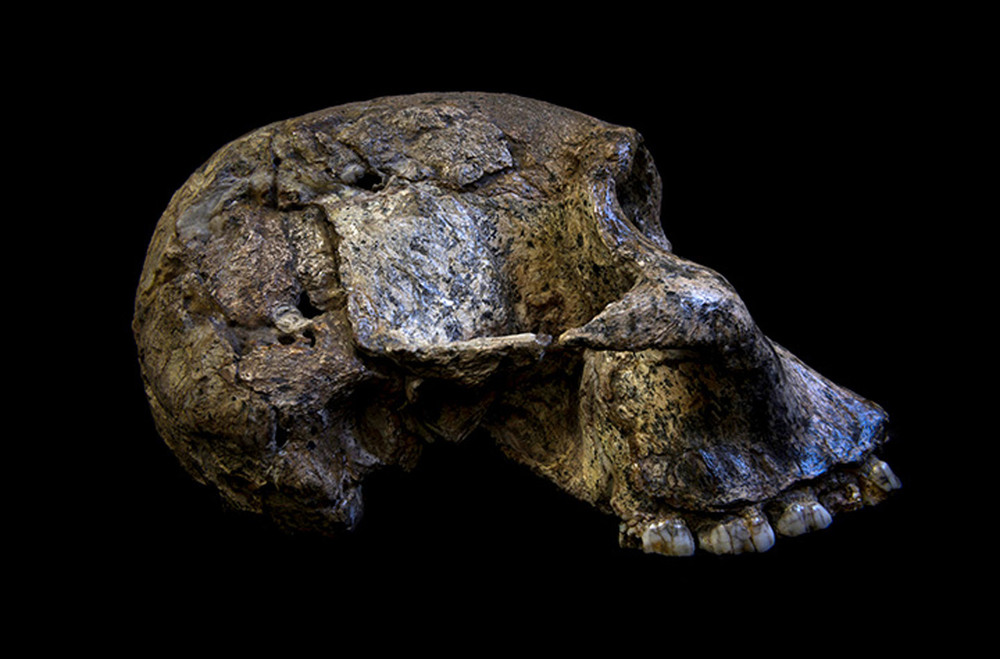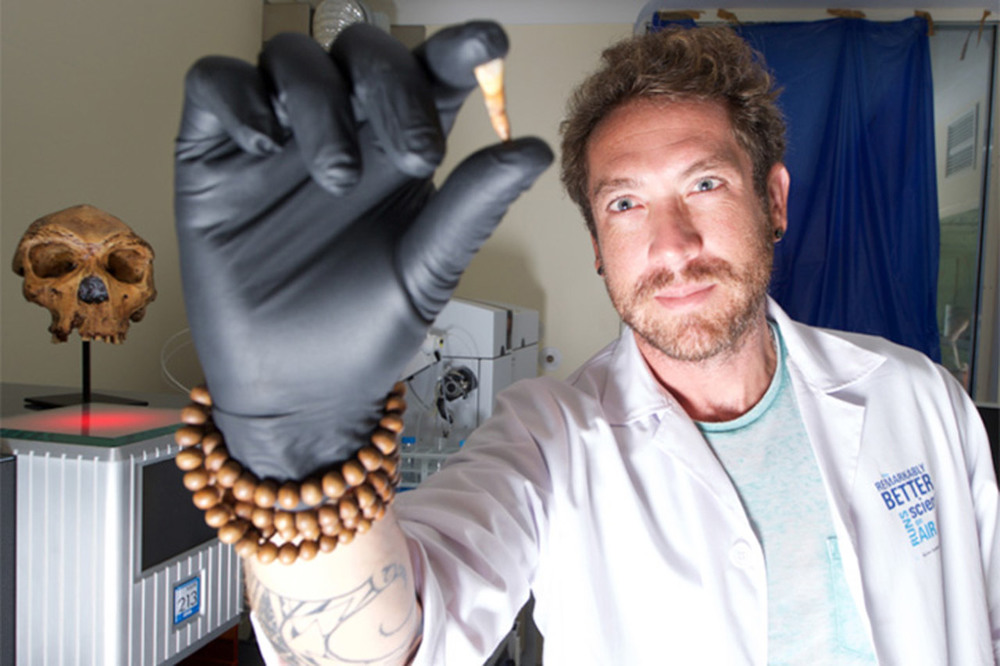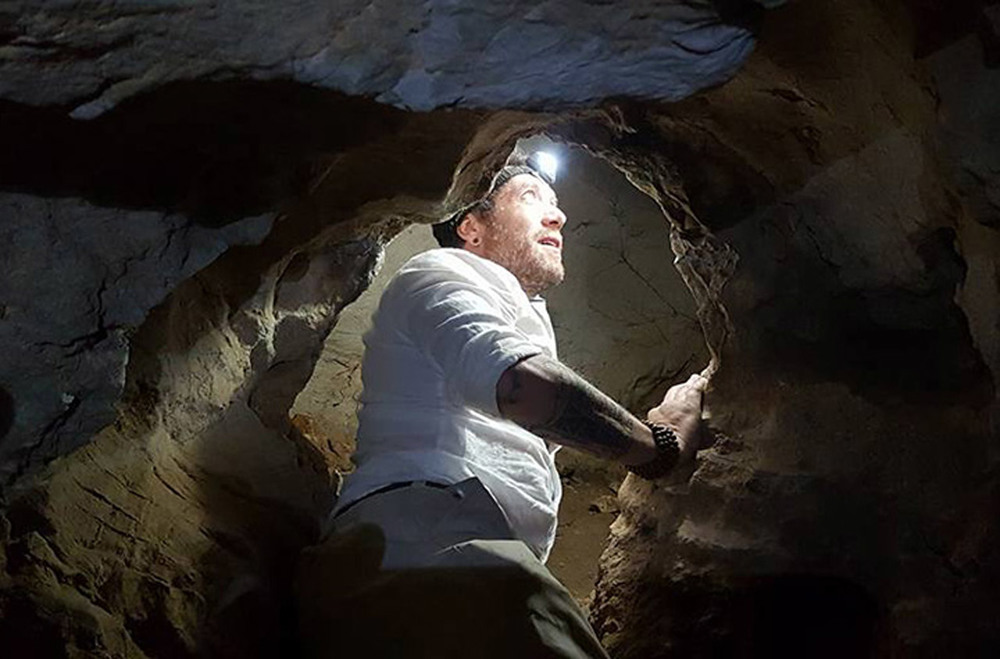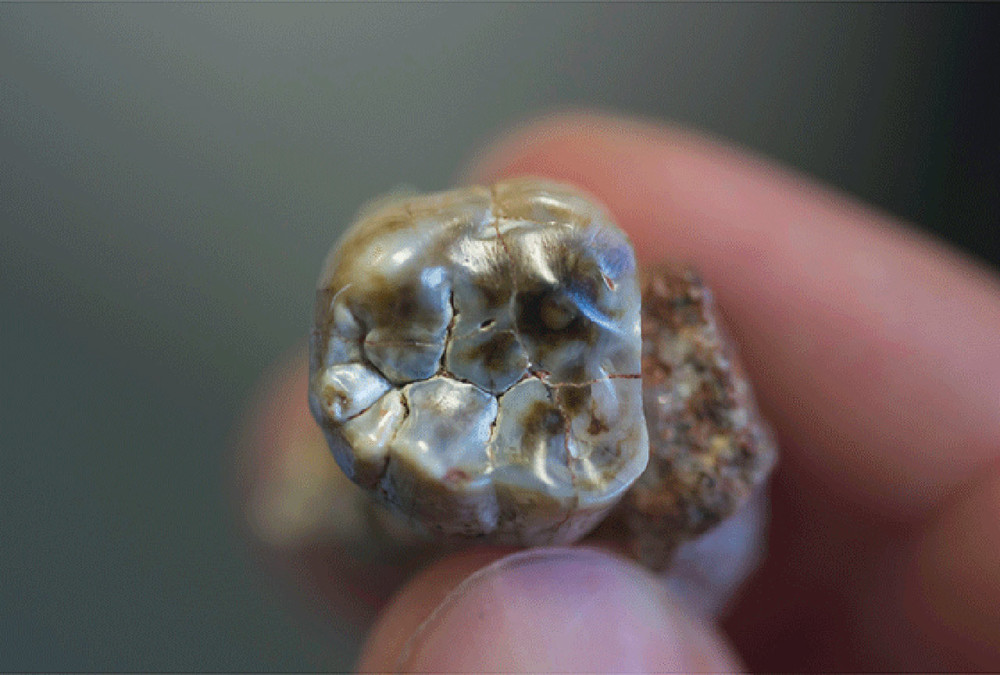SUNDAY PROFILE: Dr Renaud Joannes-Boyau studies bones, breastfeeding and evolution
Will Jackson
07 September 2019, 11:00 PM
 Renaud Joannes-Boyau holding cast of Kabwe skull in 2017.
Renaud Joannes-Boyau holding cast of Kabwe skull in 2017.Southern Cross University researcher Renaud Joannes-Boyau is one of the world’s leading experts on techniques for the analysis of pre-historic bone and teeth fragments and he made global headlines earlier this year with his discoveries about the breastfeeding habits of one of humanity’s earliest ancestors, Australopithecus africanus.
He spoke to the Lismore App about how he ended up working at a university in regional NSW and what his work means for our understanding of human evolution.
I've always been fascinated by history and archaeology. My grandma did five masters degrees and seven undergrads during her life. She became a widow at 55, so I think she was bored and so she went to uni. I'm from France and she took me all over the country and even across Europe to look at archaeological sites, cathedrals and museums and all that. So I think she gave me the virus very early on.
I remember we went to the south of France and there was the skull of a Cro-Magnon, which is a prehistoric human and the first one to arrive in Europe. I really wanted to touch the skull and I remember asking what should I do to actually touch the skull? And she said, you need to become an archaeologist. So the apple didn't fall far from the tree.
I did my first undergrad in biochemistry and genetics, a second undergrad in archaeology, a masters degree in applied physics to archaeology and then I came to Australia in 2006 to do my PHD at the Australian National University. The title of my thesis was a 'Direct Dating of Human Remains'. I worked for a while at Wollongong and then I moved to SCU.
I came to Australia for tourism first because, I always loved the country so I was very interested to actually see what it was like. But also, I had an opportunity to get a PHD scholarship with Professor Rainer Grün. He’s about to retire now, but he was the world leader in dating human fossils and also a very big figure in geochemistry, which is looking at the chemistry of teeth and bones and things like that. So when I got a PHD offer from him, it was just too good to pass up.
I came to the Northern Rivers with my now ex-wife. She had a scholarship to work at Southern Cross so I came too.

Australopithecus africanus skull. Supplied: Dr Luca Fiorenza, Monash University.
At first, SCU didn't do what I do. We are actually very, very few people in the world doing what I do. So SCU just let me work there in the beginning, but I had no salary, and then I applied for a lot of different grants from the Australian Research Council - basically the government - and then eventually SCU gave me a contract and then a fellowship and then I never left.
I built these two labs at SCU and obviously since we are publishing important research, they are not too bad.
I founded the Geoarchaeology and Archaeometry Research Group which is part of a research center called Southern Cross Geoscience.
I've got two different labs. One is the dating lab, where I've got an Electron Spin Resonance spectrometer. It's a little bit of a mouthful. These devices always have very complicated names. We call it an ESR. There's not many in the world doing dating, so it's one of only a few.
The other lab is the one we used for my latest study, which is where we do laser ablation ICPMS [inductively coupled plasma mass spectrometry]. What we do is ablate [gradually remove] a little bit of the surface of the sample with a laser that vaporises the molecules into atoms. Then these atoms are measured by the mass spectrometer. The mass spectrometer is really good at measuring the mass of elements and can tell you exactly what elements are present in your sample.
The ESR is a relatively cheap, about $200,000 and the laser ablation ICPMs is basically the price of a nice house. Probably $600,000.
Southern Cross, despite being regional has quite an amazing research infrastructure. A lot of small unis don't have that kind of equipment and a lot of big unis do not have what we have either. Certainly, if you go to the big G8 universities, they have amazing facilities but SCU is not shy in that manner.
I teach postgraduate students - so master degree, honors and PHD students - but I do not have undergraduate teaching. My work is mainly research and a lot of analysis. I travel a lot, to pick up fossils and to go on site. About five or six months of the year I'm on the road, which is very tiring now, but I do still enjoy it.
But most of what I do is basically analysis; a lot of spending time in front of computers to try to understand what the data means. And then writing, constantly writing; either writing papers or grant applications and I'm writing a book at the moment as well.
I'm very specialized in teeth. I also do bones but I would say 90% of my work is on teeth. I look at the human evolution at large, mainly the timing of human evolution. My work asks about different species: when they appear? How do they migrate and colonize new landscapes and environments? So that's one of the things that I do.
The other thing is looking at all the analysis we can do on teeth. A lot of people work on the morphology of teeth; they compare the size, the shape and so on. And then they try to find clues in it. What I do is get clues from things we can't see directly. I use analytical techniques, physics and chemistry and even mathematics, in a way to extract the data and new knowledge that we can't get just looking at it.

Dr Renaud Joannes Boyau with a Homo Naledi tooth.
I examine teeth in a similar way to the scientists who take core samples from ancient ice in Antarctica or from trees. When the ice builds up, it has layers and trees are the same. Teeth grow in layers too. You have layers forming every day and when we do the analysis, we reconstruct a map of those layers and those maps have a temporal and spatial resolution.
Everything that surrounded the individual is recorded in their teeth. So it's the geology, the environment as well, it's the diet, the water that they drink, even the pollution sometimes and so on. This is very useful, especially when we don't have any other clues. For very old fossils we have very little to go on, so the little that we have we really have to maximize.
The biggest work I've done, after I finished my PHD I developed a new technique to directly date human remains with minimal damage. This lead on to a few publications. One of the most important one was in 2017 with the dating of the oldest homosapiens ever found which was in northern Africa in Jebel Irhoud, Morocco. This was also published in Nature. We even made the New York Times front cover and so on. So that was quite a big, big thing.
In 2017, we were the first to find a way to detect a breastfeeding signal in teeth and that was a Neanderthal - the very close cousins of humans that lived in Europe and died off about 45,000 years ago. Then we did some more work early on this year and we published some work on Neanderthals that showed their migration pattern and seasonality.

Dr Renaud Joannes-Boyau in the cave in China where Giganto was found.
In July, we published an article in Nature on the Australopithecus, which is one of the earliest ancestors of our lineage, about 2.5 to 2.1 million years old. From those teeth we were able to look at the breastfeeding timing, the nursing sequence, but also we were able to see the diet, we could see a seasonal pattern - we could see that they were stressed when the seasons were bad with food shortages. We could also extrapolate some body mass fluctuations during the season and then at last we were able to look at their migration pattern and see that they didn't move much on the landscape.
The latest study was of course not just me. It was a massive group of scientists and I was just the team leader that basically gathered a lot of people that have a lot of expertise. And that's the only way you can achieve good science is by being collegial and a team player.
What we are trying to understand is who we are and where we come from as humans and basically every time we make a discovery it's a new piece of the puzzle. One of the curious things about Homo sapiens is that our babies are very demanding for the first few years. If you look at the offspring from other animals, from other mammals, like the baby horse they are able to run within a few hours. Human babies require many, many years to be independent and mature. And with modern society it is getting longer and longer. You can ask my parents. It took me many years to be mature.

Australopithecus africanus tooth. Supplied: Dr Luca Fiorenza, Monash University.
The Homo sapiens is unusual because we have quite a short breastfeeding period, but very, very long maturation and we want to know: why is it the case? We look at previous species and try to understand: when did it start? How did it evolve?
One of the things that we start to see is that one of the reasons that Homo sapiens have been so successful is because in evolution we are very adaptable. We are very opportunistic.
If you line up all the animals that ever lived on Earth and then you had to pick one that you believed would be the most successful animal, you probably wouldn't pick Homo sapiens. They've got no fur, no big teeth, no protection. But they are so opportunistic, so resilient, so adaptable to the environment that they’re able to constantly colonize new environments.
And I think that's what we see in a Australopithecus africanus. This species is living in an environment that is not very suitable. It's not very good in terms of food supply and so on but probably also very little predation.
They chose this environment instead of moving to a better place where they might have more food. Instead, they stay there and adapt to this place by having a periodical breastfeeding system, being more diverse and broad in their diets, being very opportunistic. So they would go for fruit, flowers, leafs, roots, probably meat as well, carcasses. Anything they could find. It's kind of like a clue to why Homo sapiens are so successful.
We have a lot more studies actually that will come out soon as well. We continue to look at the timing of different species, continue to look at the way Homo sapiens migrated around the world.
We want expand this study on Australopithecus Africanus to other species of the human lineage. So the first Homo which is our genus, we want to look at the earliest one that appears on the landscape around two million years ago and see if there is any difference with Australopithecus.
We also want to look more at primates in general and much older primates. In the primates, you have the separation with monkeys a long time ago. We want to look them and see what they've been doing and how they evolved in terms of breastfeeding and diet and so on.
The ultimate goal is to understand better where we come from and how we got to where we are and to reconstruct this evolution of nursing across the ages.
